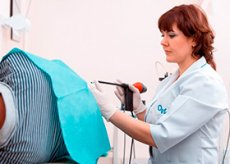Medical expert of the article
New publications
Prolapse and prolapse of the rectum
Last reviewed: 07.07.2025

All iLive content is medically reviewed or fact checked to ensure as much factual accuracy as possible.
We have strict sourcing guidelines and only link to reputable media sites, academic research institutions and, whenever possible, medically peer reviewed studies. Note that the numbers in parentheses ([1], [2], etc.) are clickable links to these studies.
If you feel that any of our content is inaccurate, out-of-date, or otherwise questionable, please select it and press Ctrl + Enter.

Rectal prolapse is a painless protrusion of the rectum through the anus. Prolapse is a complete prolapse of the entire rectal wall. Diagnosis is made by examination. Surgical treatment is aimed at correcting prolapse and prolapse of the rectum.
Transient small prolapse of the rectal mucosa alone is often observed in completely healthy infants. Prolapse of the mucosa in adults does not resolve on its own and may progress.
Rectal prolapse is a complete prolapse of the entire rectal wall. The underlying cause of prolapse is unclear. Most patients are women over 60 years of age.
Symptoms of rectal prolapse and prolapse
The main visible symptom is protrusion. It may occur during straining, walking or standing. Rectal bleeding and fecal incontinence may often be observed. Pain is uncommon.
To determine the full extent of prolapse, the physician should examine the patient in a standing, squatting, and straining position. Rectal prolapse is differentiated from hemorrhoids by the presence of mucosal folds. Anal sphincter tone is usually decreased. Colonoscopy or barium enema should be performed to rule out other pathologies. Primary neurological disorders (e.g., spinal cord tumors) should be excluded.
What do need to examine?
How to examine?
Treatment of rectal prolapse and prolapse
In infants and children, conservative treatment of rectal prolapse is sufficient. Causes of straining should be eliminated. Tightly holding the buttocks together with tape between bowel movements usually promotes spontaneous resolution of the prolapse. In adults with prolapse of the mucosa alone, resection of the mucosa may be performed. In cases of prolapse, abdominal surgery may be necessary. In elderly or debilitated patients, an artificial thread or synthetic loop may be inserted around the sphincter ring (Thirsch procedure). Other perineal procedures (e.g., Delorme or Altemeier procedures) may also be considered.


 [
[